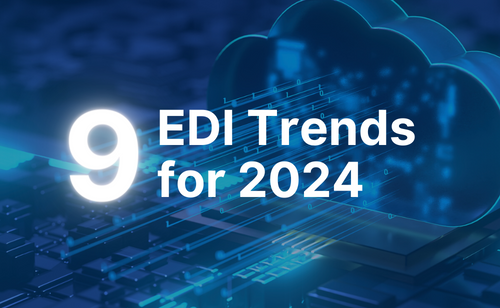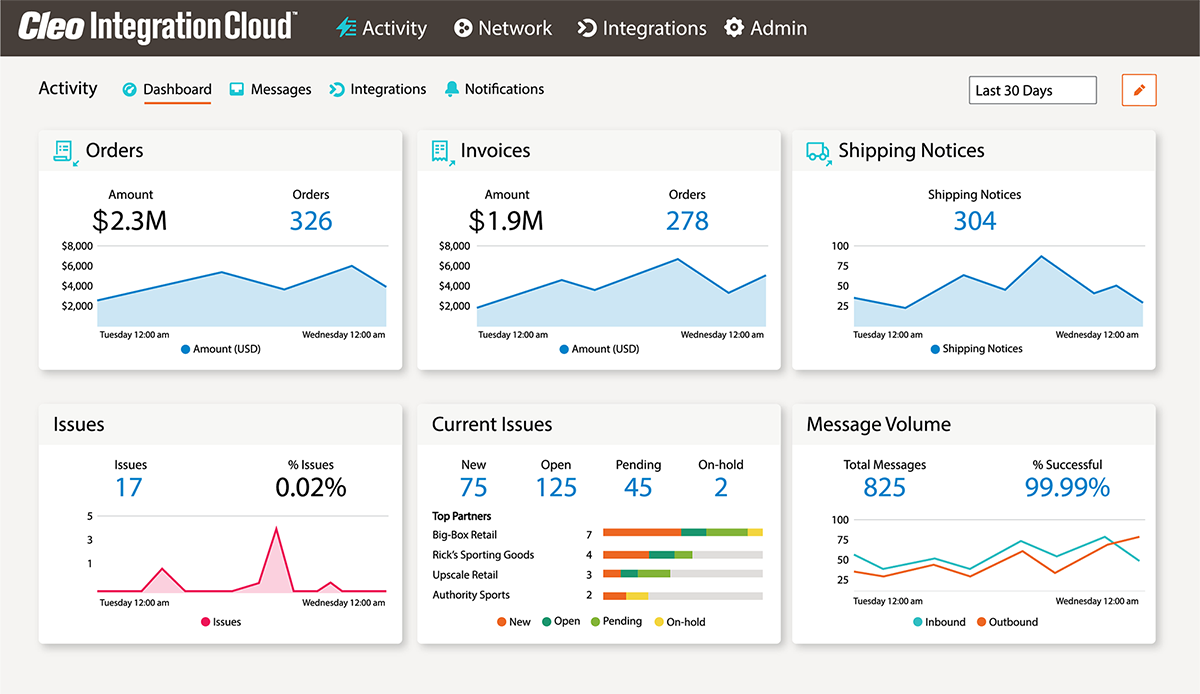9 EDI Trends for 2024

In this article, we cover 9 EDI trends to be aware of going into 2024:
- AI Integrated EDI Solutions
- EDI is Key for Digital Transformation Initiatives
- Small Businesses Seeing Rapid Growth in EDI
- EDI & API (Together Forever)
- In eCommerce, EDI Plays a Significant Role
- Healthcare Remains a Strong EDI Sector
- Peppol and Other e-Invoicing Mandates Are Expanding
- EDI Outsourcing Services Are Becoming More Appealing
- EDI Integration Enabling Business Control and Visibility
Despite forecasts of EDI technology dying out in the future, it is not only here to stay but is expected to continue expanding. Globally, the EDI (electronic data interchange) market is projected to reach $49.21 billion by 2027.
The adoption of EDI integration technology has continued to rise as more organizations realize the immense value it brings. For example, businesses are reaching for the ability to:
- Create cost- and time-efficient integrations quickly
- Gain real-time visibility into orders, integrations, and partners
- Accelerate partner onboarding to increase business agility
- Enable non-specialist personas to manage multi-application integration initiatives
- Enhance overall procedures and make the use of different technologies more agile
EDI integration is becoming less of an optional "nice-to-have," and more of a requirement for many businesses. Larger organizations, such as Walmart, leverage integration technology to strengthen supply chain control. They demand new trading partners adopt and implement EDI as the base price of entry in order to do business.
Read: What Does it Mean to be EDI Capable? | Read: Where Does Artificial Intelligence (AI) Fit In The Supply Chain?
1) AI Integrated EDI Solutions
AI and EDI, while initially unrelated, are two prominent technologies in today's business world. As we see artificial intelligence continuing to break into nearly every sector of business, there is no doubt artificial intelligence (AI) can and will be integrated with electronic data interchange (EDI) to enhance B2B processes. AI can help to automate and streamline EDI-based processes in several ways, including:
- Automating data entry and conversion: AI can be used to automate the entry and conversion of EDI data into different formats, which can save time and reduce errors.
- Improving data quality: AI can be used to identify and correct errors in EDI data, which can help to improve the accuracy of B2B transactions.
- Automating exception handling: AI can be used to identify and handle EDI exceptions automatically, which can free up IT staff to focus on other tasks.
- Optimizing supply chains: AI can be used to analyze EDI data to identify opportunities to optimize supply chains, such as reducing inventory costs or improving delivery times.
For example, a company can use AI to automate the process of matching EDI purchase orders with inventory levels. This allows the company to quickly identify and fulfill orders, even when there are changes to demand or inventory levels. By automating manual tasks, improving data quality, and optimizing supply chains, AI can help businesses to save time, money, and improve efficiency.
Here are some additional thoughts on the future of EDI and B2B meets AI:
- AI could be used to develop new EDI standards that are more flexible and adaptable to the changing needs of businesses.
- AI could be used to enhance new EDI solutions that are more affordable and accessible to small businesses.
- AI could be used to develop new EDI-based applications that help businesses to collaborate more effectively with their suppliers and customers.
Overall, it is clear that AI has the potential to transform EDI into a more powerful and efficient tool for B2B communication and collaboration. When searching or considering EDI service provider options, it is vital to look for an EDI provider who is leveraging technological developments like AI and innovating in their solutions. EDI providers who are investing in AI are better positioned to help their customers automate and streamline their EDI processes, improve data quality, and optimize their supply chains.
2) EDI Is Key for Digital Transformation Initiatives
After the COVID-19 pandemic sent shock waves through businesses in every industry, companies realized how unprepared their technology, operations, and processes were to handle changes in supply chains. Organizations quickly began scrambling to bolster their technology stacks to address these issues.
EDI is an example of a key technology that businesses began flocking to in order to transform and innovate their digital ecosystems. Companies quickly recognized EDI's value, as the leading EDI solutions offer:
|
|
|
|
|
|
|
|
|
|
Looking at the above list, it becomes clear why the demand for EDI is now skyrocketing. This single piece of technology can fully automate countless processes which result in greater efficiency, cost-savings, and happier customers.
3) Small Businesses Are Seeing Rapid Growth in EDI
Contrary to popular belief, EDI is not solely for large corporations. In fact, small and medium-sized businesses are seeing tremendous growth by harnessing EDI technology. The reason for this is two-fold.
The first is that smaller businesses have fewer resources (time, money, and human capital) to go around. Therefore, EDI allows small and medium-sized businesses to automate processes instead of having to rely on and pay human employees who work slower. Secondly, if small and medium-sized businesses wish to grow, investing in EDI allows them to trade with larger organizations while simultaneously handling more business transactions. Overall, EDI helps businesses operate more efficiently while enabling them to process more transactions and conduct business with larger organizations.
4) EDI and API (Together Forever)
EDI and API can both send/receive data between two organizations. They do possess different functionalities and each has its own strengths and weaknesses. However, EDI and API are complementary technologies that work best together.
API integration augments EDI and gives deeper context to the B2B integrations with your digital ecosystem, while EDI helps enable downstream business processes and data orchestration. For example, APIs may be necessary to look up catalog inventory or check pricing within an eCommerce platform. If a customer decides to make the order, EDI may be necessary to kick-start the ordering, shipping, and fulfillment processes. Both processes, you might argue, are equally critical to business success.
Additionally, APIs are critical to integrating data with your digital ecosystem because they bring more communication flexibility than standard exchanges like EDI. APIs are hailed for their real-time connectivity advantages, as they can connect with partner and SaaS applications quickly and efficiently.
Whether onboarding a trading partner, customer, cloud service, or SaaS application, each has its own unique configuration, customization, and integration challenges. But the fact is, your competitors are facing the exact same challenges. Whoever can most quickly adapt to each communication and data requirement - whether it's EDI, non-EDI, or API - will separate themselves and earn new business.
5) In eCommerce, EDI Plays a Significant Role
In 2019, EDI amassed $7 trillion in B2B electronic sales. By 2021, this number rose to $8.38 trillion, as well as accounted for 76.5% of all digital sales. Furthermore, EDI grew year-over-year by 8.3% in 2021. These numbers reveal that EDI remains the dominant force in eCommerce as it continues to expand.
As time goes on, we will see more interconnectivity between EDI and B2B eCommerce. This is because EDI assists and performs a wide range of functions that relate to commerce and supply chains. This includes order processing, invoicing, procure-to-pay, and more. As eCommerce continues to rely on EDI to automate various processes, eCommerce will become increasingly reliant on EDI.
6) Healthcare Stands as a Strong EDI Sector
The booming healthcare industry relies on EDI. The reason being is that EDI is HIPAA compliant, meaning it ensures data privacy for healthcare patients. As HIPAA regulations continue to expand, EDI has kept up with the requirements making it a solid and reliable communication method for healthcare providers.
Healthcare EDI usage does not solely pertain to hospitals and doctors' offices though. Companies in big pharma and medical device manufacturing/sales are also utilizing the technology. These types of businesses use EDI for everything from inventory management and order accuracy, to secure communication and delivery windows.
7) Peppol and e-Invoicing Mandates Are Expanding
Peppol was created to outline the standards, methodologies, and technical specifications for e-procurement within the European Union (EU). Peppol is an EDI protocol that government organizations and suppliers use to streamline the procure-to-pay process. Government bodies in the EU are mandated to use Peppol to eliminate the issue of each trading partner possessing unique requirements and standards. This makes EDI implementation, communication, and onboarding more efficient and less complex.
Peppol has expanded since its 2012 debut, with the technology also being mandated for government use in Malaysia. Countries such as Australia, Singapore, Japan, and New Zealand use Peppol as their standard of choice, but there is no legislation or regulation mandating its use yet. As more countries digitize processes, Peppol will increase its adoption rate.
8) EDI Outsourcing Services Are Becoming More Appealing
If a company does not outsource its EDI services, it should have an internal employee(s) that is responsible for managing all EDI-related responsibilities. This can be a time-consuming and intricate role as the employee is responsible for onboarding new trading partners, creating new connections, building maps, tracking orders, monitoring for issues and discrepancies, performing error resolution, and more. That also means a company has to find a skilled employee that can perform the job, as well as pay them for their services. Currently. EDI professionals are in high demand but there is a limited supply.
Smaller businesses may not be able to afford to pay a full-time employee to handle all their EDI tasks. For larger organizations, managing a large EDI ecosystem can quickly become complex and overwhelming for internal teams. This is where EDI outsourcing comes into play.
Companies can hire outside providers to tackle all EDI-related responsibilities, so they do not have to worry about the technology and processes at all if they do not want to. Some EDI managed service providers will let customers create custom plans where they decide which EDI tasks will remain in-house and which will be outsourced to the provider. Additionally, with many EDI solutions offered via the cloud, most outsourcing companies can perform the entirety of their work remotely over the internet.
9) EDI Integration Enabling Business Control and Visibility
EDI used to be a black box of sorts, meaning that companies that deployed the technology—especially those that used managed services—could not see into EDI's inner workings. For example, companies did not have visibility into when and where errors were occurring and data collection was minimal and inaccurate. This made it extremely difficult to correct and prevent errors before they caused detrimental disruptions. Additionally, companies could not rely on the data they were collecting to inform decision-making because it was scarce and inconsistent.
However, leading EDI solutions have since evolved into much more user-friendly platforms that offer in-depth transparency and control. For example, some solutions offer error notifications where the platform will text or email users when and where an error is occurring. Users can then quickly jump into the platform and fix the issue before it disrupts the supply chain. Furthermore, users can create custom dashboards that collect real-time data from the various systems the EDI platform is integrated with. This data can be used to identify strengths and weaknesses in a supply chain, perform optimizations, identify trends, influence key decision-making, and more.
Lastly, users can handle partner onboarding, integrations, and map building on their own with innovative, easy-to-use tools. For example, pre-configured connectors and pre-built maps make it a breeze for companies to quickly get up and running since they only need to adjust the templates according to their needs. This saves a great deal of time and hassle while giving control and visibility to the customer. Having control and visibility over the strategy and execution of EDI ensures that organizations can be confident in the services they provide, as well as their internal operations.
EDI has advanced tremendously since its inception decades ago. What was once seen as a waning technology has now evolved into a highly desirable and necessary tool that brings companies immense value. If you have questions about what was covered in this blog, EDI, or Cleo's products and services, contact us at sales@cleo.com or +1.815.282.7695. Or explore some of our educational resources through our content hub.
Cleo is here to help companies achieve business control by transforming B2B integration. The end-to-end integration visibility offered by the CIC platform stretches across EDI, non-EDI, and API interfaces. This gives technical and business users the confidence to quickly onboard trading partners, allow application integration, and speed up revenue-generating business processes.
Take a look at our EDI demo library if you're ready to stay ahead of the curve and streamline end-to-end data transformation, orchestration, and integration with secure EDI from Cleo.

About Cleo

